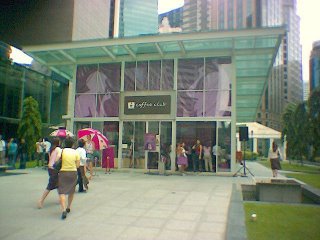Buangkok MRT station may open in January
By Goh Chin Lian
Nov 11, 2005
The Straits Times
TWO years of lobbying by grassroots leaders in Punggol South may finally have paid off, with plans underway to open Buangkok MRT station in January.
The Straits Times understands that Transport Minister Yeo Cheow Tong could reveal the details officially tomorrow.
The station would have opened only in 2008, based on the Land Transport Authority's previous guideline that there must be 2,000 to 3,000 housing units within 400m of a station to justify opening it.
But Mr Yeo indicated in August that the guideline was not set in stone.
He said the 400m radius could be extended to 500m and the station could open as long as there were close to 2,000 units within that larger area.
Based on figures from Pasir Ris-Punggol Town Council, there are already about 2,300 units within 500m of the station.
Asked to comment on the plans to open the station, the authorities, plus transport operator SBS Transit and even the usually vocal Pasir-Punggol GRC MP Charles Chong were keeping quiet.
But sources told The Straits Times the go-ahead has been given.
Before the station can open, operational trials have to be conducted, including ensuring that the trains stop properly at the station. When The Straits Times visited the station earlier this week, maintenance staff were working inside and the ticketing machines were switched on.
The opening of the station should bring an end to a two-year saga that started in June 2003, when SBS announced, four days before opening the $4.6 billion North-east Line, that Buangkok station would stay closed.
Many residents in the area felt cheated, particularly those who had bought a home in the belief that the station would open. Instead they have to walk, cycle or take a feeder bus to Hougang or Sengkang stations if they want to use the MRT.
Mr Chong and his grassroots leaders lobbied SBS to change its mind, producing polls which showed people were willing to walk more than 400m to the station, but SBS rejected the findings.
Several ministers spoke publicly on the issue and held out the promise that the station would open once more people moved in.
Unconvinced, someone placed eight cut-outs of white elephants on a road divider outside the station before a minister's visit in August, sparking a public debate about protesting and political expression, and ending with the culprit receiving a stern warning from the police.
So is the planned opening of the station a sweetener for the upcoming general election?
Chairman of the Government Parliamentary Committee for Transport, Mr Ong Kian Min, did not think so.
'It's coincidental,' he said. 'There's been a lot of pressure for them to open Buangkok station. The pressure has been piling up. It's good for them to review and make a decision.'
To most people, Singapore is the great urban experiment, a city-state known for its obsessive sterility and eclectic architecture. It’s the financial hub of Southeast Asia and a hot spot for shoppers. What many travelers miss, however, are Singapore’s glorious green respites; habitat havens worlds away from the dense city core where the population tops 6,430 people per square kilometer (16,654 per square mile). Here are three great and inexpensive ways to take a walk on Singapore’s little-known green side—a perfect way to get away while on a short trip to this island city.
MacRitchie Reservoir
Seemingly hidden, yet right in the heart of Singapore, are lush, rainforest trails, lakeside boardwalks, and the expansive parkland of the MacRitchie Reservoir. Part of the 2,000 hectare (4,923 acres) Central Catchment Nature Reserve, MacRitchie was first established in 1868 to save this important watershed region from the wholesale clearing that has occurred everywhere else on the island. As of the early to mid-19th century, Singapore has been stripped of 90% of its forest cover, but the reserve persists.
The highlight of MacRitchie is a moderate 10.5 km (6.5 mile) round trip hike to the Tree Top Walk—a 250 m long (820-foot) suspension bridge connecting the reserve’s two highest points. It offers a spectacular canopy-level contrast to the usual under-story view from the jungle floor.
If you’re not up for a full hike, try the gentle 3 km (1.9 mile) Nature Trail along the water’s edge, through primary and secondary forest. Even on this walk you’ll be sure to see red-eared slider turtles and plenty of long-tailed Macaque monkeys – resist feeding them, for your sake as well as theirs! With a cocked ear you can catch the calls of kingfishers, eagles and bulbuls. MacRitchie also offers kayak rentals and scenic picnic spots.

 (2048 x 3072 px, 180 dpi)
(2048 x 3072 px, 180 dpi) Singapore Botanical Garden
Nearly a century and a half ago, the local Agri-Horticultural Society had the foresight to establish a leisure garden, which later blossomed into the Singapore Botanical Garden. It’s impressive 52 hectares (128 acres) are organized thematically with enough variety to keep even non-plant-oriented people entertained.
In the Marsh Garden’s ponds are clumps of Paper Plant, so named for their use by the Egyptians. Palm Valley has over 220 species of palm, and in the Sun Rockery you’ll find the plump, cartoon-like succulents, plants swollen with water to survive even the driest conditions. Kids will love the Swiss Ball Fountain—a 700 kg (1,543-pound) granite ball kept in a constant spin by water current—and the collection of miniature Bonsai trees. If you like to know how to grow what you eat, you’ll enjoy the Herbs and Spices garden, the Beverage Crops, and the Nut Trees and Medicinal Trees.
For a peek at pre-development Singapore, stroll through the Rain Forest, which even in 1889 was described in the Gardens’ guidebook as one of the only stands of “original jungle left on the island…. [giving] the visitors some idea of the wonderful richness of tropical vegetation.”
No visit would be complete without touring the famed National Orchid Garden where staff has been breeding orchids since 1928. The result is the world’s largest display of tropical orchids with over 1,000 species and 2,000 hybrids to admire.
The Orchid Garden is open from 8:30 a.m. to 7 p.m. and costs SG $5 (US $3) for adults, SG $1 (US $0.59) for seniors and students, and is free for children under 12. Otherwise entrance to the Botanical Gardens is free; general Garden hours are 5 a.m. to midnight and there are several bus options.
Pulau Ubin (Granite Island)
For a real treat, take the 10-minute bumboat ride from Changi Point Ferry Terminal, and visit Pulau Ubin, the only remaining holdout of rural Singapore. Roughly 100 villagers still live here, making their living from farming, and providing provisions to tourists. A small village surrounds the jetty where you’ll find a few shops, restaurants and ample bike rentals. From there, take off and enjoy the sounds, scenes, and wildlife of the island.

 (3072 x 2048 px, 180 dpi)
(3072 x 2048 px, 180 dpi) At the north end of Pulau Ubin, you can easily see the Malaysian coast, as well as a curious fence demarking the border. There are a couple of beaches for swimming, and if you forget to pack snacks, not to worry: practically every home that dots the island has a stand selling cold drinks, and the island’s home grown delights—fresh young coconut to sip, durian fruit (creamy and tasty if you can get past the putrid smell) and jackfruit. Most people make the island a day trip, but there’s also a reasonably priced resort that offers a long list of recreational activities.
A bike for the day, or part of the day, costs between SG $2 (US $1.19) for a completely adequate vehicle (keep walking till you round the bend to find these) and SG $12 (US $7.18) for a brand new mountain bike, which is hardly necessary. There are also tandem bikes and bikes with training wheels for little people. The bumboat fare is just SG $2 each way and it leaves frequently, as soon as there are 12 passengers to ferry over. To get to Changi Point take the MRT to Tanah Merah then bus No. 2, about an hour from the city center.









































